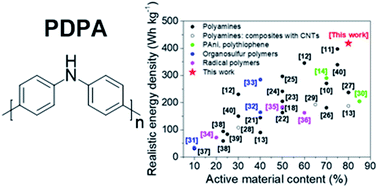Polydiphenylamine as a promising high-energy cathode material for dual-ion batteries†
Abstract
A serious drawback of organic cathode materials for metal-ion and dual-ion batteries is the poor electronic conductivity of cathode materials leading to relatively low loading of active material in the electrode composite. Using excessive amounts of electrochemically non-active conductive fillers and polymeric binders approaching 40–60% of the total electrode weight makes organic cathodes non-competitive with respect to their inorganic counterparts, which operate efficiently with 3–4 times less ballast weight. In this work, we present non-doped polydiphenylamine (PDPA) as a highly promising positive electrode material for lithium and potassium based dual-ion batteries. In contrast to the vast majority of organic cathodes, the good intrinsic conductivity of PDPA allowed the spectacular increase of its loading in the cathode composites up to 80% thus reducing the ballast weight down to 20%, which brings the performance of organic materials closer to that of state-of-the-art inorganic cathodes. In particular, PDPA showed an impressive energy density of up to 523 W h kg−1 for lithium- and up to 462 W h kg−1 for potassium half-cells with an active material loading of 80%, which outperforms significantly the characteristics reached for previously reported polyaniline (PAni) and polytriphenylamine (PTPA) polymeric cathodes under the same conditions. Analysis of the literature data revealed that PDPA delivered record-high values of energy density recalculated for full cathode mass (418 W h kg−1) among all organic polymer cathodes for dual-ion batteries reported so far.



 Please wait while we load your content...
Please wait while we load your content...